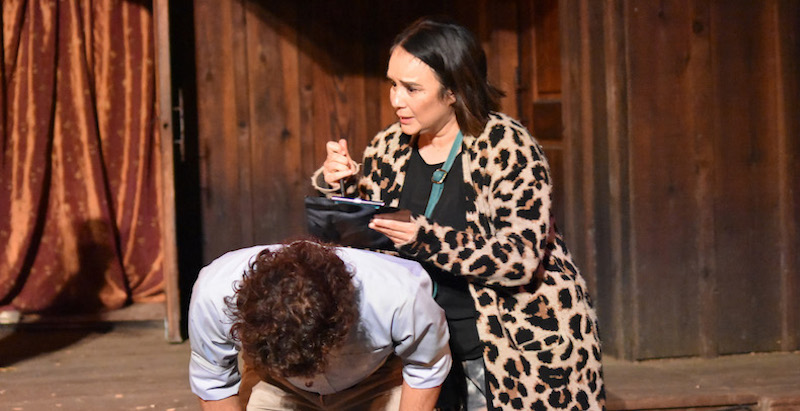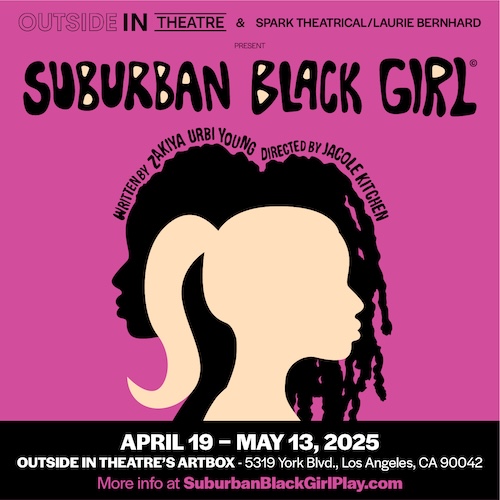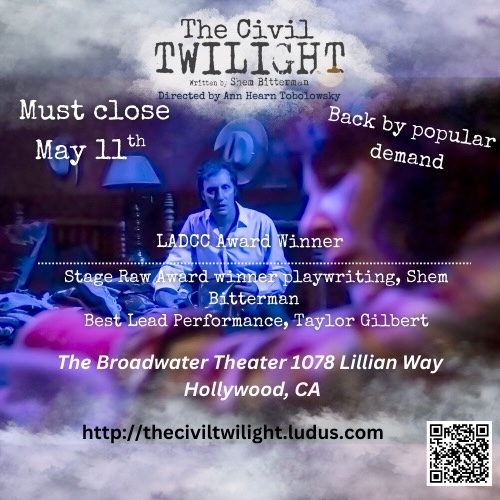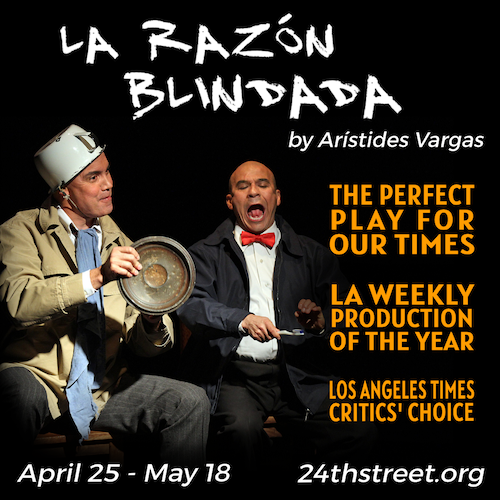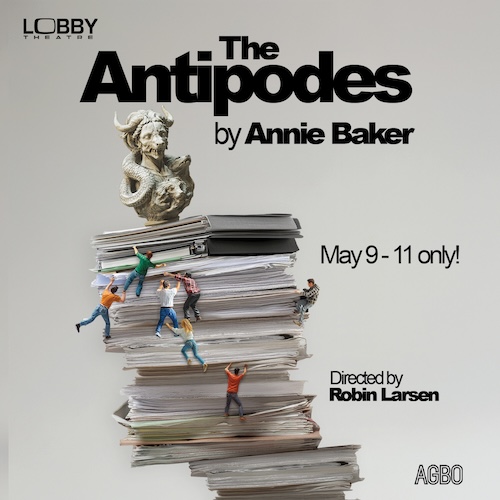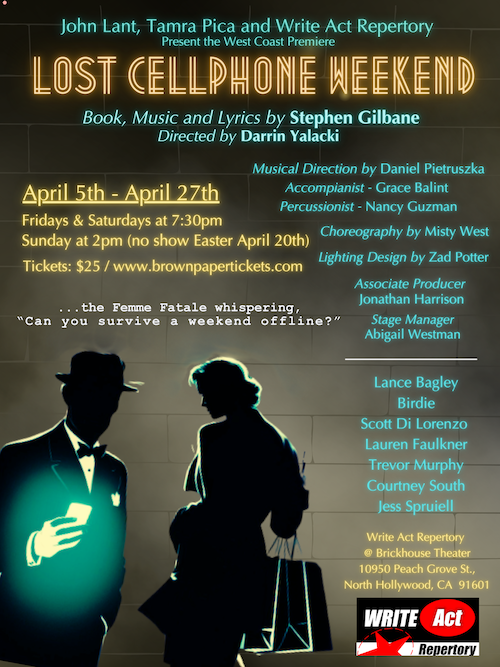Timothy Willard and Xochitl Romero (Photo by Ian Flanders)
Reviewed by Steven Vargas
Will Geer Theatricum Botanicum
Through October 12
RECOMMENDED
Choosing a sperm donor is not easy, especially for Paola Aguilar (Xochitl Romero). She can’t get the full picture of each donor by simple statistics. She needs to understand their nuances to feel comfortable using his sperm for her IVF treatment. She distills it to a “vibe.”
To capture the vibe, she turns to the audience for advice. She’s struggling to decide how tall her donor should be.
“How tall is your kid?” she asks a couple in the audience. They smile.
“35 inches,” the mother replies.
The rest of the audience laughs before Aguilar quips, “That’s small.”
In Will Geer Theatricum Botanicum’s production of The Hispanic/Latino/Latina/Latinx/Latiné Vote by Bernardo Cubría, the audience is as much a character as the actors on stage. The story follows Aguilar as she takes on a job for thepolitical party to help them understand “the Latinx vote.” As she revamps their polling and interview strategies, she must balance microaggressions in the workplace and her IVF treatment. Cubría’s merging of the topics works and results in a well-crafted story. In Aguilar’s journey to understand the vibe of sperm donors, she realizes that the same applies to the voting patterns of the Latinx community. She can’t understand her community through a statistic, however. She must get to know them face-to-face. Furthermore, she turns to the audience.
This is exactly what Cubría did in developing the play. The Hispanic/Latino/Latina/Latinx/Latiné Vote is inspired by the statistic that more than 30% of Latinx people voted for Donald Trump in the 2016 election. When commissioned by Florida Studio Theatre in Sarasota in collaboration with Milagro in Portland, Oregon, Cubría sought to capture the authenticity of the Latinx vote by interviewing about 500 Latinx voters in the two cities. As a result, the show feels real and visceral.
This is seen when the crew of political players made up of Kaj Lutken (Steven C. Fisher), Nicola Ramirez (Emily Jerez), Bernard Robinson (Max Lawrence) and Rebecca Feldman (Laura Schein) conduct interviews with actor Roland Ruiz performing as various Latinx interviewees. Their goal is to promote their political party — which is only described as “the” political party — and understand how Latinx people vote. During the interview scenes, Ruiz switches between personalities and characters with his hyper-specific movement quality, transforming from an energetic and sexual Florida woman to a stoic and toxic man. He fully embodies them by changing his posture, mannerisms and tone. Ruiz shines.
Some of his comments as the various personalities are hard to swallow for both the audience and the characters. It feels unsettling, but that’s the point. These words are from real people. The show simply operates as a telephone or broadcast to show audiences who may be too comfortable in a political bubble that this is the breadth of our nation. It isn’t something to fear, but to empathize with.
Cubría’s craft heavily incorporates audience interaction to bring the sentimentality of his interviews to a more localized sphere. Aguilar will ask the audience simple things like “What is the ideal height in a man” to complex questions like “What part of your identity is most important to you.” The responses of the audience help drive the story forward. Romero navigates these moments with ease. She has incredibly quippy responses and takes care of the audience, traveling to the seating area and connecting directly with people. Her asides are often comical but can also get incredibly heartfelt.
When she is in the doctor’s office for the embryo transfer, she sits still in the gynecology chair reflecting on her fear of being told to calm down. In the space, she is on the far-left balcony. Despite the distance from the audience, she pulls everyone in. The once joyous crowd is silent, listening. Romero’s power to command the stage is remarkable.
Some of Willow Geer and Cubría’s direction doesn’t do the show justice in making these scenes land. They adapt well to the outdoor environment by ensuring the performances are big and animated. For the most part, it works. But sometimes Ruiz and ensemble members — including Atlas Alma, Blaire Battle, Michael DiNardo and Timothy Willard — distract from the narrative by with their over-the-top tone. For example, when Aguilar receives her embryo transfer, Ruiz holds the sperm with both hands in between his pointer finger and thumb and presents it to the audience like communion during Catholic mass. While comical, the gesture is far removed from the story.
There is a also a need for specificity in movement. When Aguilar sits in an interview and is triggered by a toxic man telling her to calm down, the play speeds through time. Ruiz changes character repeatedly, and the environment swirls on stage with set pieces shifting drastically. The room they were once in is no longer recognizable. Here, the movement feels disjointed, and the cacophony of voices made by the characters that the production tries to achieve sounds more like a staccato hum. At the end of the section, everyone but Aguilar shuffles back without a clear direction of their body, never landing on a pose but shifting as if they don’t know where to go.
The direction is strongest in the scenes that take place in tight spaces. When Aguilar is in the bathroom with Ramirez following an outburst where she calls her “not Latinx,” even though she is half-Cuban, there is a strong tension that fills the entire theater. The performance is snappy as they argue about what it means to be Latinx. Jerez finds the complexity in her character by navigating the perfect moments to shout or simmer as she shares Ramirez’s experience with a distant father. The scene is captivating. Similarly, Robinson and Feldman’s characters have earnest scenes with Aguilar that force her to address her biases and provide Aguilar with a dynamic character arc.
As the show nears the end, the audience interaction no longer feels like a quirky theatrical device, but a necessity. Aguilar shares that the reason she cares so much about her community is because of a racist encounter her father experienced when she was young. This hits home for people of color. The moment forces people to reflect on the first time they recognized racism.
The show is not just about the people on stage. It is about us as a nation. Cubría’s creation asks that we not be complicit in the state of American politics. The voices we judge are not just comments online. They’re real and are tethered to human life. It’s a big concept to confront, yet Cubría does so, impressively.
Theatricum Botanicum 1419 N. Topanga Canyon Blvd., Topanga; in rep; check website for schedule; thru Oct. 20. Running time: Two hours including intermission. www.theatricum.com


